ANIMAL FORMS
Most of us spend our sketching time looking at a reference image or a live model as our pencil follows the lines we see, inch by inch or centimeter by centimeter. When we stop to consider our work, we realize we’ve got adjustments to make! The proportions are all over the place. The balance is off. Our model looks wonky. Our sketches can often be altered to be more true-to-life, but the “rescue mission” stage will likely leave you deflated.
I want to open your eyes to a way of understanding a subject as you see it. The first step is to see animals as a collection of shapes or forms. American mid-century artists focused on shapes of flat color. This approach helped inform how I look at subject matter, and I am so grateful. Using cut paper or solid blocks of gouache forces us to think creatively about what is before our eyes. Details must be lost and nuances in forms are reduced to the essential. Minimalism led to an even greater exaggeration of diminishing a subject to a single shape, literally cutting dispensable curves or parts.
ACTIVITY:
SINGLE-SHAPE ANIMALS
What if you had to represent an animal with a single shape? It’s a challenge! Grab some construction paper and a magazine featuring animals and try a few! Make three animals by using a single shape of cut paper for its body mass. Then, add a few marker lines to bring them to life. Pushing your creative brain is a great way to grasp the subject.
WHAT YOU’LL NEED
![]() Paper in solid colors
Paper in solid colors
![]() Scissors
Scissors
![]() Markers
Markers

A COLLECTION OF SHAPES
Now look at animals as a collection of shapes. Beginning with the body mass, add the head—often reduced to a circle or ellipse. The legs may be more angular, like long rectangles connected at joints. Notice in the collection below how shapes are longer or shorter, angular or curved depending on the animal. Draw a few that are not shown here.
Understanding animals as shapes gives you confidence to approach any animal! I often don’t even sketch before painting. I go straight to putting brush to paper by forming their body mass one shape at a time. Once I have the silhouette of an animal on the page, it’s ready for a few shadows and the fun details that excited me in the first place!

ACTIVITY:
PAINTING SHAPE-BASED ANIMALS
Try my go-to method for getting some fun animals on the page! And we will not use pencils! Follow these steps to paint a few animal silhouettes yourself by building up the form shape on shape. Don’t worry about selecting accurate color choices for this exercise.
WHAT YOU’LL NEED
![]() Watercolor paper
Watercolor paper
![]() Watercolor paints in three color values
Watercolor paints in three color values
![]() Medium-size brush and smaller brush
Medium-size brush and smaller brush
![]() Optional: markers
Optional: markers
1Begin by painting the shapes of the animal’s body parts in a single color with a medium-size brush. Start with the head or the body mass. Use a light color.
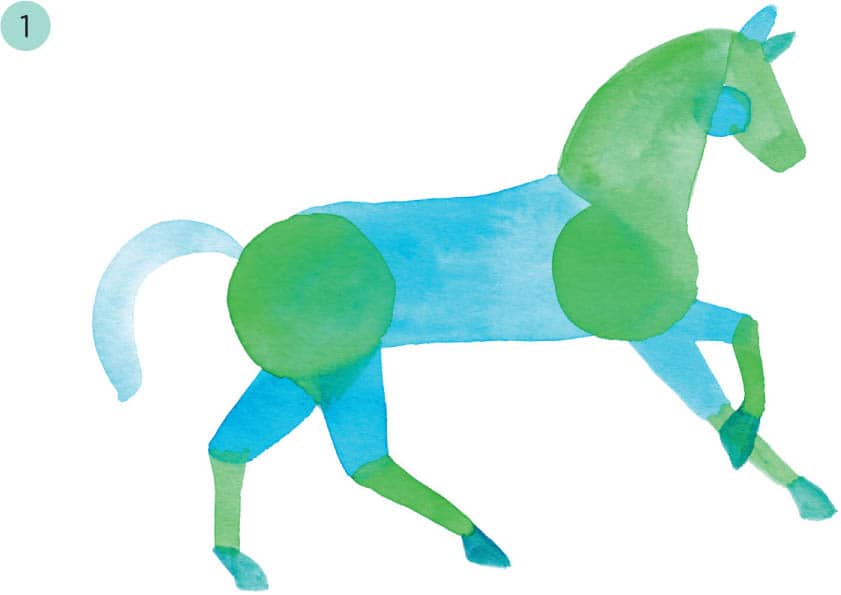
2Refine the edges of the animal form with the same color. Use a smaller brush to paint the outer edges more accurately. Smooth junctions of the shapes. Notice texture, perhaps the animal has fur. Add features such as a mane or paws.
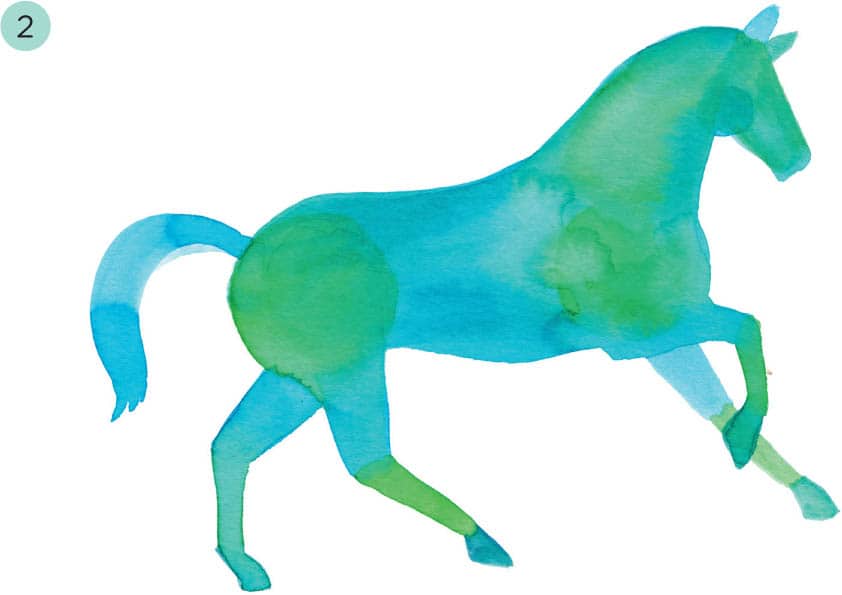
3Select a slightly darker color to add shading to a few areas such as under the head, surrounding the snout, or the ridge of the hip.
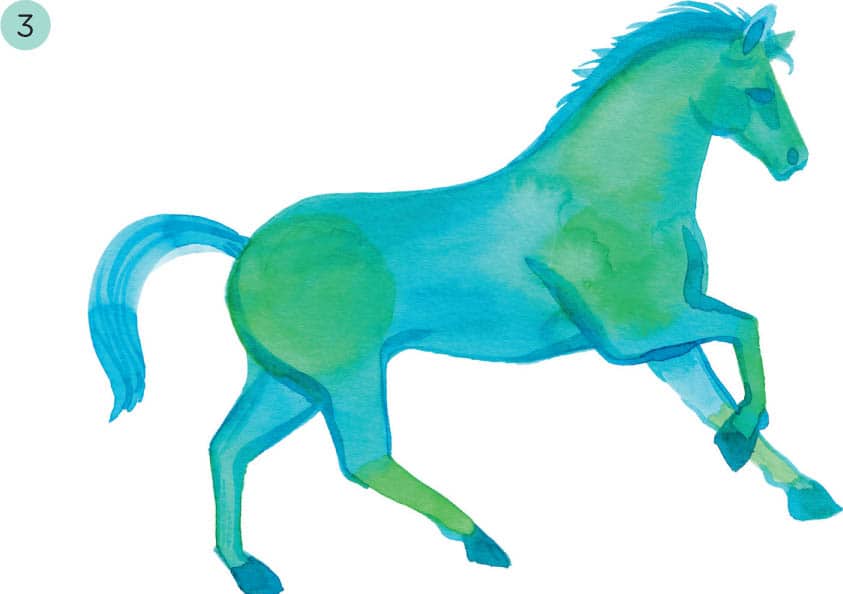
4Paint the small details of the face with the darkest color option of the three. You may use markers for this step.
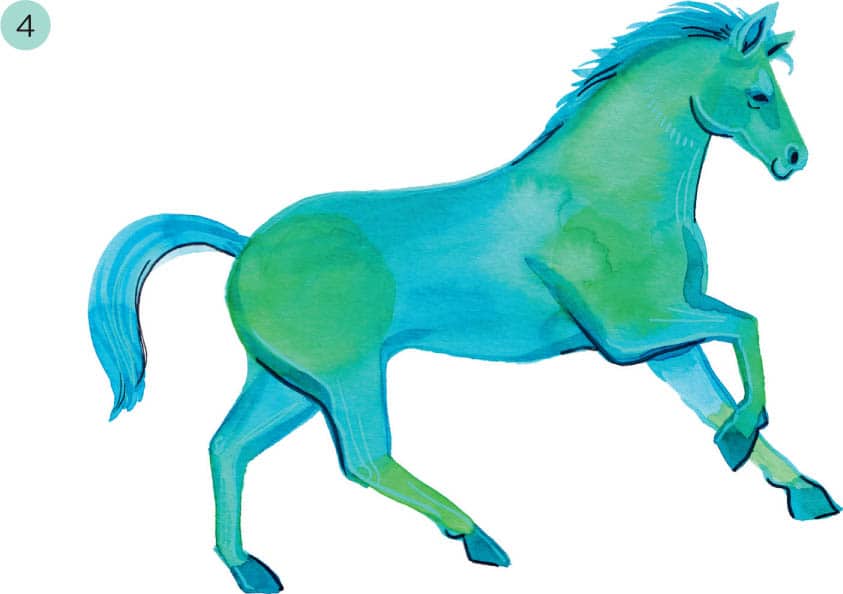
Look at how easily you painted an animal simply by focusing on its shapes! This method helps you bypass intimidation and understand the forms you’re looking at.
SHAPES WITH PURPOSE
The parts that make up the critical mass of our animals will inform what it looks like and ultimately how it moves and behaves. For instance, you may have noticed a rabbit has long legs formed like a springy clothespin. Its slow neighbor, the mole, has short legs with little bounce in them. A horse can trot gracefully with its complex legs of multiple joints. The dolphin can whiz through the water with its sleek, torpedo-shaped body.
As you continue to draw and paint these beings, pay attention to what their features lend themselves to. Drawing a long neck may communicate what a giraffe looks like, but contemplating the function will improve your drawing—just imagine the giraffe reaching for leaves to munch on!
As artists, we place more than lines and strokes on a page. Whether we draw the whole picture or not, the story in our minds can pique our viewer’s curiosity and create a narrative in their minds. Our drawings carry our hearts and our thoughts to better communicate with our audience: Drawing a more accurate rhinoceros is only the first step. Our aim is to see these aspects of creation collide seamlessly.
In these sections, we’ll look at each part of the animal and reflect on the variety of options within each segment. Noting the size and contour of each part within the structure will guide us to the animal’s nature and identity, and ultimately teach us how to draw it.
Head Mass
Start at the top and focus on head mass. Think about a bobcat. It has a round head, even though it seems to have a wider face due to its strong whiskers. Keep it simple. Pay attention to the dominant shape.
Round: Generally equidistant all around. Think of a brown bear’s round head, or the smaller head of a bat or a squirrel.
Oblong: More elliptical than a perfect sphere. It could be an oval head or one that transitions into a pronounced snout like that of a horse or a moose.
Non-distinct: Heads that seem to lie well within the animal. Animals that roll into balls come to mind, such as a porcupine, hedgehog, or guinea pig. Owls have heads that conform to and meld into the rest of their bodies. Or the animal may have a seamless silhouette by design, such as that of a dolphin or whale, made to glide through the water.

Snout: Nose and/or Mouth
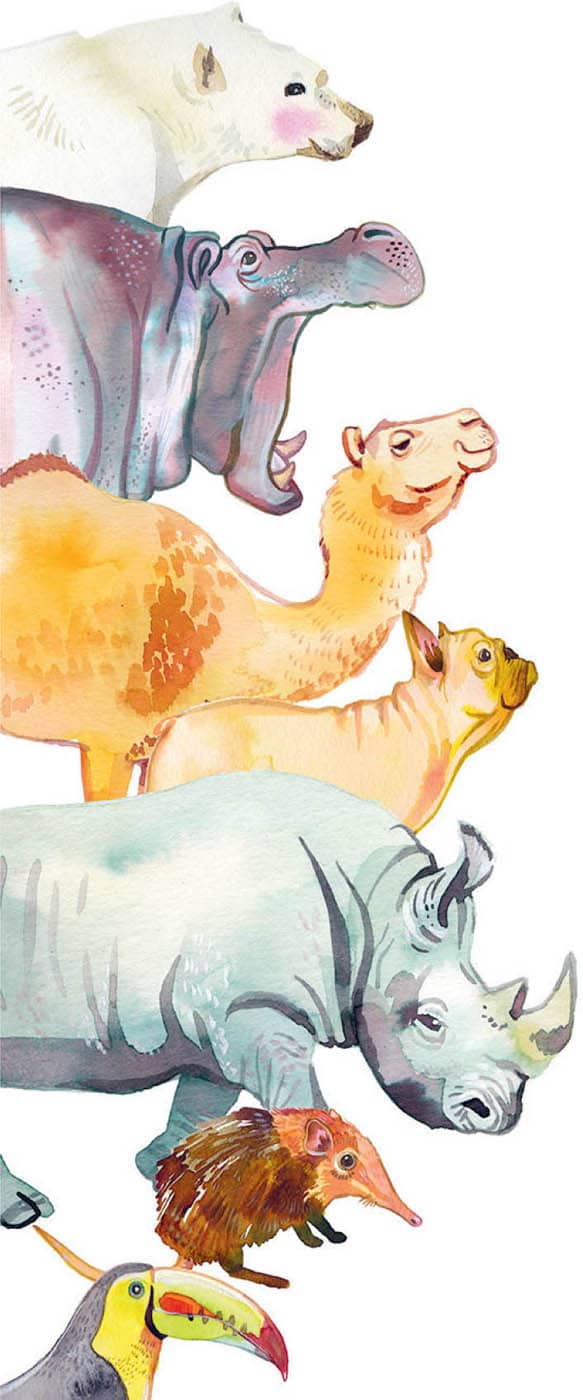
Many animals have snouts consisting of a protruding nose and mouth underneath the jawline. Snouts are technically part of the head as the skull often extends to include this area. This feature may be quite a large distinguishing factor when drawing your animal! Here’s a quick list of animal examples:
Box snout: Short-haired cats, some dogs (such as a Labrador), bear, squirrel
Rounded box snout: Hippopotamus, baboon, guinea pig
Pronounced muzzle: Camel, moose, zebra
Flat and round: Pig, gorilla, pug dog, French bulldog
Long and pointed: Collie dog, rhinoceros, mouse, opossum
Extended: Elephant, elephant shrew, tapir, aardvark
Beak: Duck, bird, goose, platypus
Ears
Listen up! Ears are much more defining in animal types—perhaps comparable to how much importance we humans place on our eyes. What’s a bunny without floppy ears and what’s a cat without pointy ones? (Answer: a dwarf rabbit and a Scottish fold cat.)
Pointy or triangular: Most cats, foxes, Husky dogs, pigs
Small and curved: Bear, beaver, chipmunk, camel
Floppy: Lop rabbit, hound dog, goat
Long and tall: Llama, bobcat, kangaroo

Limbs
Let’s talk appendages and analogous structures! Said nobody, ever. These indispensable parts attached to the main body construct its makeup. Some animals seem to have extra joints or backward-facing joints. Take them one by one as you build your animal.
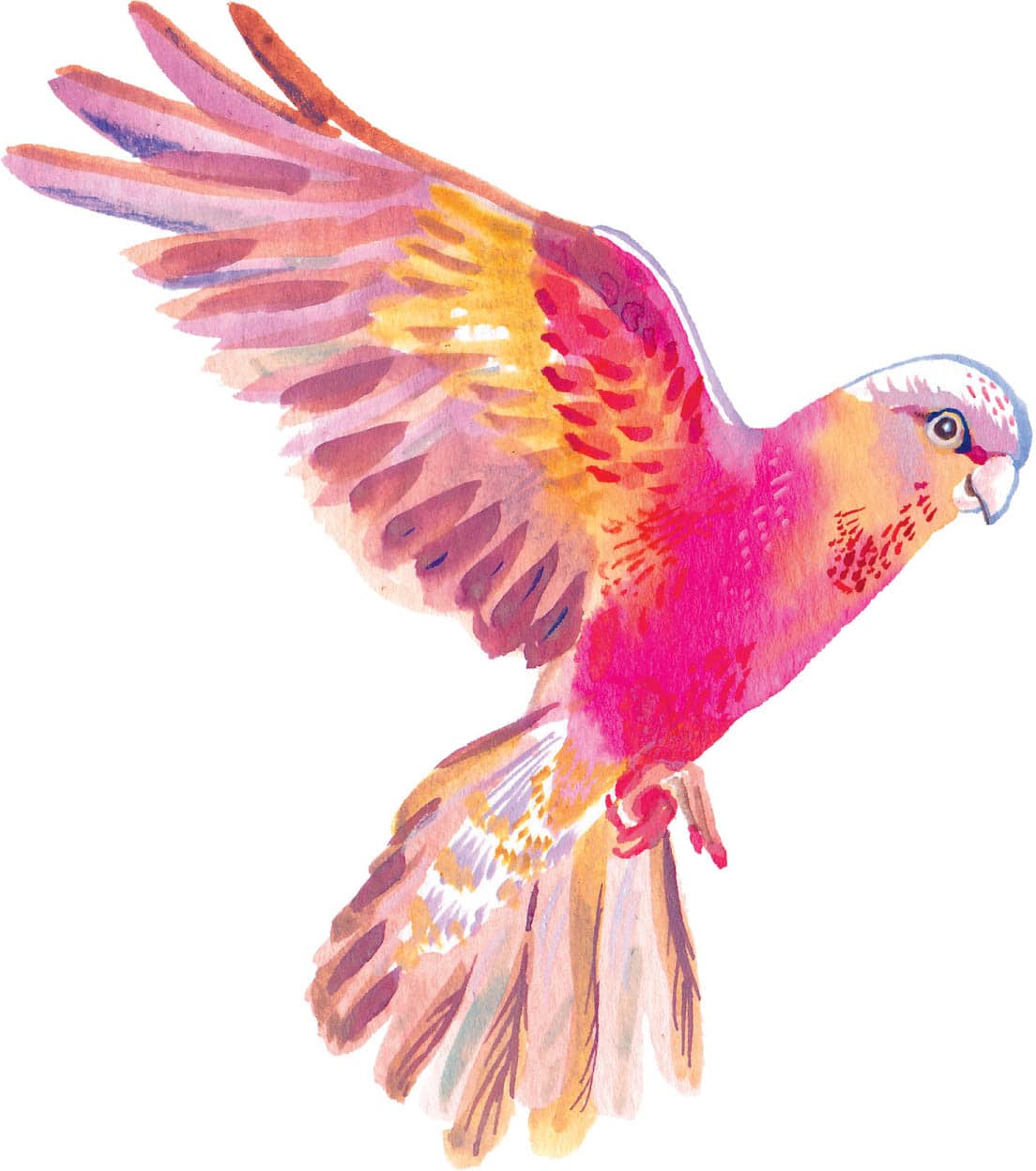
Forelimbs
Not all limbs are the same . . . or the same size, or go by the same name. We’ll simply call these forelimbs—labeling momentarily by function for the sake of drawing. The forelimbs of an animal may be shorter than the hindlegs, such as with a chipmunk, or they may be similar in length but different in structure, such as a koala.
Wings
Wings can be tricky. Notice the texture. A bird’s wing may contain a variety of feathers. And of course, not all wings are the soft, feathery type, such as a bat’s.
Notice how feathers are nicely arranged by rows or how different layers of feathers are stacked upon each other, subtly changing in density, width, and thickness as they progress toward the tip. Then pay attention to the color. Ever tried to paint a peacock or even just a peacock feather? What a wild collection of colors and patterns! The change in color could happen by rows or within one feather.
It may not be a linear pattern, but the rhythm will help you. Also note if the colors blend into the next or if they are distinct. Now note the structure. Some wings span from the joint to the body like that of a chickadee bird. Others bend halfway like that of an eagle.
Rely on a few reference photos taken from different angles and at different degrees of wingspan; you may not notice a wing’s fold or bend until you see it half open.


Legs
Don’t let those legs perplex you. A chameleon’s short legs and claws help him cross over tree branches. Some legs are disproportionately long, such as the dangling spider monkey. Study legs species by species as you draw. Notice how they’re joined at the hip and often bend at the middle, forming two or three portions.
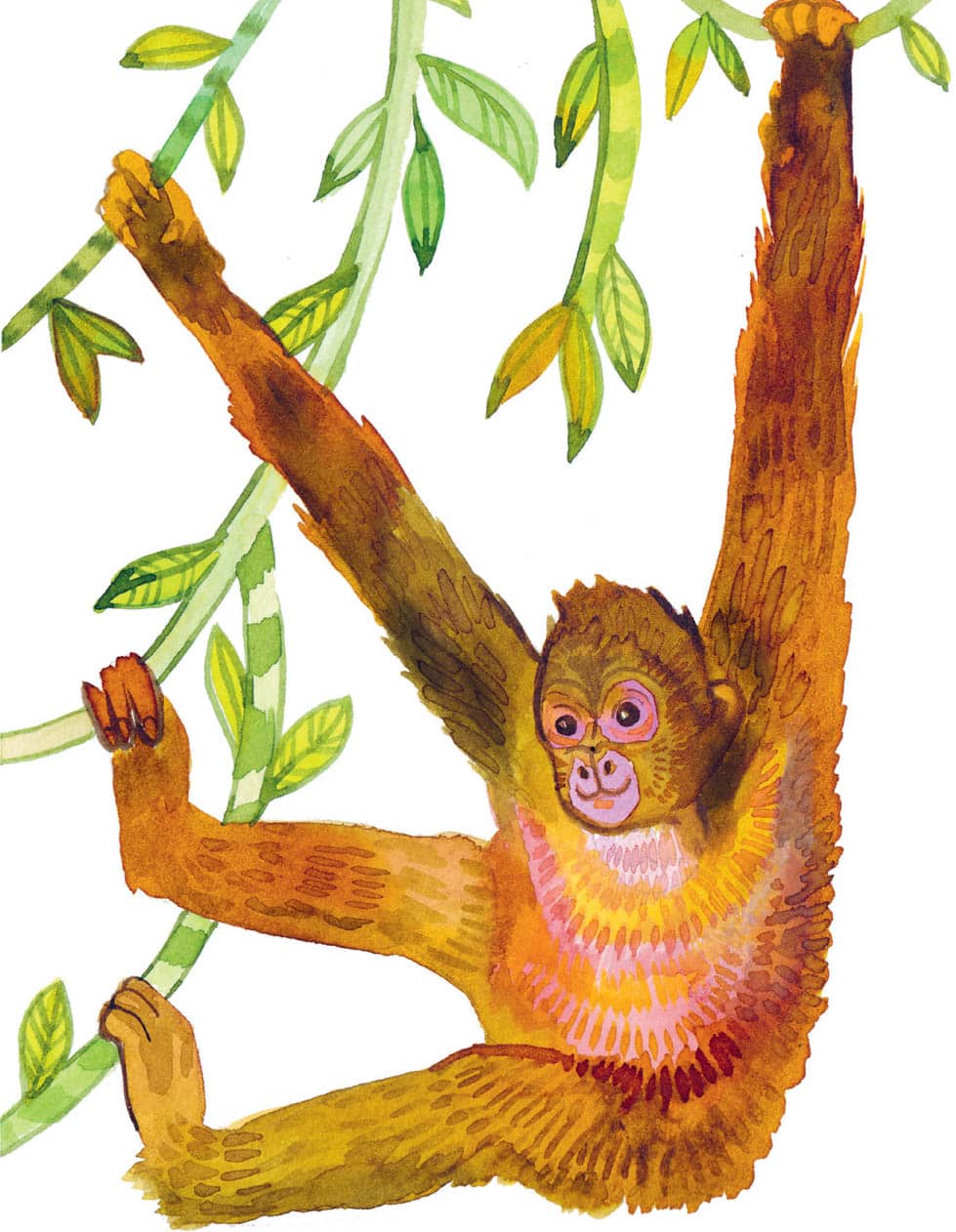
Fins
Fins can maintain balance and direction (e.g., a dorsal fin), but those we regard as limbs move and often operate like arms. Whale fins can be short compared to their body mass (e.g., a blue whale) or long flippers (e.g., a humpback whale).
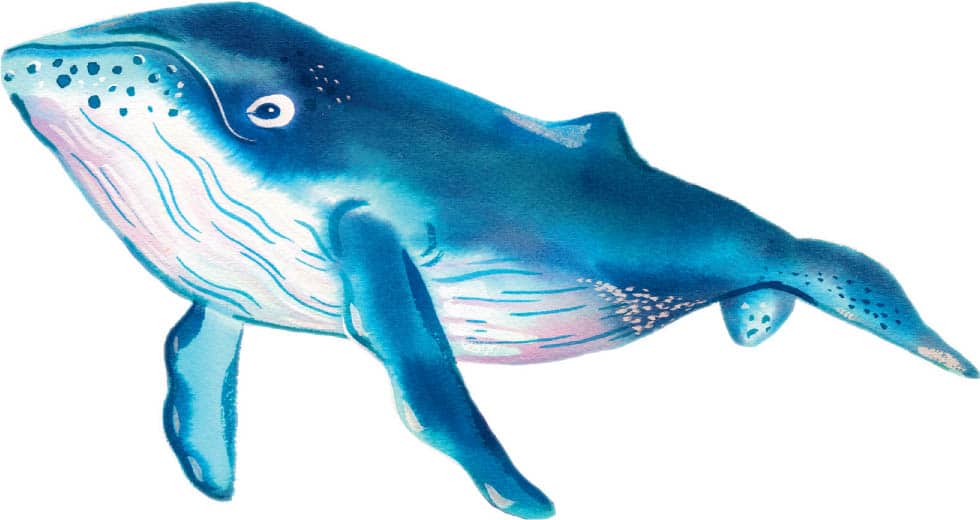
Tail
Fluffy or slick, long or short, tails offer a distinct detail that sets an animal apart. Tails are not purely decorative. They often provide balance, swat bugs away, or act as a “fifth arm” to grab onto tree limbs. Tails can often be expressive, being a clear tell of fear, curiosity, joy, and calm. Sharpen your mind’s eye by thinking of the distinct tails of these animals:
Long: Monkey, cheetah, wallaby, ring-tailed lemur
Short: Bobcat, giant panda, sheep, rabbit
Bushy: Koala, hare, red panda, gray fox
Mane: Stallion, donkey, zebra
Flat: Beaver, platypus, leaf-tailed gecko, flying squirrel
Skinny: Pig, donkey, lion
Tail fin: Dolphin, seal, whale, shark

